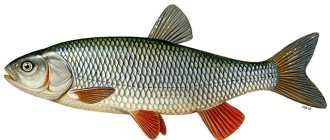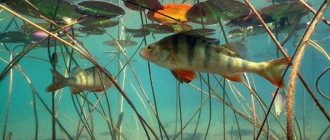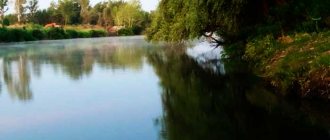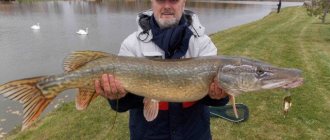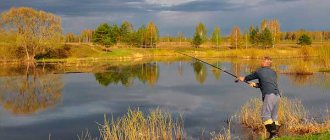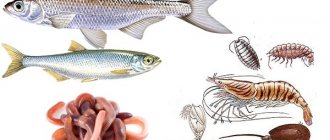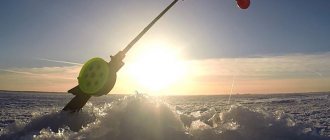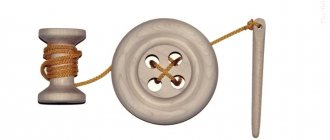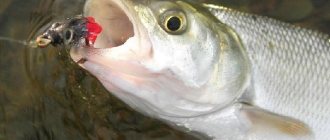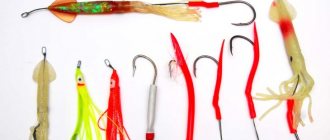Fishing on the Black Sea from the shore Good evening, dear friends! Glad to see you on the fishermen's website. Here you will find a lot of useful and interesting information. Just today, let’s talk about the topic: fishing from the shore on the Black Sea - the main features and nuances of fishing. Most of us love to sit on the shore, breathe the sea breeze, and admire the sunsets. But still, it is better to combine business with pleasure, and spend time usefully, bringing home a good catch. If you are interested in such a pastime, then the published material will allow you to do this. Our family goes to the coast every year, and we always go fishing. I often witness when people leave with nothing, and the reason for their failures lies in the wrong fishing location or gear. So that you do not make their mistakes, I will tell you what the specifics of fishing in the Black Sea from the shore are.
Features of sea fishing
Sea fishing, unlike rivers and lakes, differs in conditions and fishing techniques. The population of fish is denser than in fresh water bodies, the current is always strong, with waves, and the water is clear, so the fish are always active, even in winter. It is better to fish in calm, calm weather, preferably in August.
Many marine inhabitants are shy and when the wind increases, in order to avoid being thrown out to dangerous rocks by the current, they go deeper, to the bottom.
The fishing technique should be more intense, and casts should be far and correct to achieve better results. Fishing on the Black Sea from the shore is special:
- Possibility of using only hard rods and artificial baits.
- Lack of bite in the heat.
- Strong resistance when fishing for fish.
- A gregarious habit of individuals.
- Fishing mainly only for large fish.
Fishing in the Black Sea with any gear is most successful in August–September. If the weather is favorable, the fish are biting quite actively in October. In the heat of summer, catches are rare; the fish go deeper, closer to the bottom.
What's so special about fishing from the shore?
It is believed that fishing is effective as far as possible from the shore, at depth. Let’s say that you don’t have a boat, and you only have a spinning rod in your arsenal. But this is also an interesting process in its own way. For spinning, a spinning reel and a rod of any length are suitable.
It is better to fish at night, when the fish swim to the shore in schools. Suitable baits include shrimp, mussels, and sea worms.
A large catch from the shore is possible with a donka up to 5 m in length and a sinker weighing at least 200 g, as well as with a surf fishing rod with a reel spool size of over 4000 mm. Hooks and attachments also need to be selected correctly for a particular fishing rod. Fishing from the surf in bad weather and storms is good with surfcasting.
It is during bad weather that many worms, mollusks, and crustaceans are thrown ashore. These are the best baits for predators, and the fishing method is good for long casts to places rich in fish, located 10-12 m from the shore.
For extreme sports enthusiasts, the type of fishing “rock fishing” from the rocks is suitable. The fish swims for prey to coastal areas, to high rocks. A telescopic rod up to 5 m long and with a sinker up to 200g is suitable for the tackle.
Places for successful fishing
You can fish at sea:
- From the shore, for both beginners and experienced fishermen, using any gear, even homemade ones. It is good to fish for large fish with a telescopic fishing rod 7-8 m long. Fishing is successful remotely and close to the shore. Almost any bait can be used. In stormy weather from the shore with strong winds, you need to cast the fishing rod as far as possible, at least 10 m.
During the surf period, there is a high probability of catching large predatory individuals; during a storm, the release of worms and mollusks is huge, which is very tempting for fish.
- From a cliff, but such fishing is quite extreme and is suitable only for professionals, people with skills in this matter. Fishing is successful using a telescopic rod with a sinker of at least 200 g from cliffs and rocky peaks.
- From the pier, in places near the beach. Catching medium-sized fish is suitable for beginners using spinning rods. Usually at the height of the season it is crowded, fishing is massive and widespread.
What kind of fish is found in the Black Sea
This area is home to almost 180 species of fish. Often caught by fishermen:
- Ruffs.
- Flounder.
- Mullet.
- Gobies.
- Sea bass.
- Red mullets.
- Horse mackerel.
- Sprat.
- Herring.
- Acne.
- Anchovy.
In summer it occurs:
- Tuna.
- Pelamida.
- Mackerel.
- Rarely, but you come across sultanas.
- Beluga.
- Sargans.
- Gorbyl.
- Dark.
There is an abundance of fish of different sizes in the Black Sea. Gobies are popular and are a delicacy for many. To attract their attention, it is better to place the bait at the very bottom. There are a lot of mullet in the sea near the shore, singili, a medium-sized fish with an orange spot on the cover of the gills.
Fishing in the Crimea, closer to the Caucasus, is successful for small horse mackerel.
Quite large individuals are found not far from Georgia and Abkhazia. Horse mackerel often recklessly searches for prey, literally jumping out of the water. If you find yourself at sea at such a moment, catching horse mackerel will not be difficult.
Catching sea crucian carp with a fishing rod is successful in the waters of the Black Sea; shrimp will be used for bait. Beautiful bright wrasses are found in the coastal zone closer to rocks and stones overgrown with algae. The wrasse fits on almost any tackle. There are a lot of perches in the sea; anglers love to catch this type of fish.
There are, of course, a lot of crabs, shrimps, and mussels of various sizes in the sea.
But poisonous fish can also be caught on a hook: dragonets, sea ruffes, which are similar in appearance to other species. You need to be careful. If the fish is unfamiliar to you, it is better to release it back to avoid poisoning.
Fishing on the Black Sea from the shore - what gear and bait is best to take
The tackle can actually be anything, but it’s still the same:
- Durable and powerful.
- Resistant to frequent gusts of wind.
- Easily cast over long distances.
- Withstands powerful water vibrations.
Spinning rods, float rods, telescopes, bottom gear, and tyrants are effective and popular.
- The spinning rod, which is quite resistant to corrosion, is suitable for sharp hooking.
Tuna, croakers, crucian carp, anchovy, eels, sea bass, bonito, gobies, and croaker weighing up to 5 kg go well with it. Preferred places for spinning fishing are rocks, piers, away from the beach. - Donka is primarily used for catching small fish of medium size species. The donka is effective for use in shallow water, in calm places. The tackle is good for beginners when fishing for eels, crucian carp, sea bass, croaker, and flounder.
- The telescopic fishing rod is suitable for long casting, fishing from rocks and catching beluga, anchovy, tuna, bonito, herring, sea crucian carp.
- A float fishing rod is ideal for catching small fish, but you need to choose the fishing line and hooks for this gear correctly.
Fishing from the pier in places with an average depth of no more than 2 m with a muddy sandy bottom is successful for perch, crucian carp, bonito, garfish, horse mackerel, gobies, and eels.
- Tyrants are homemade fishing rods with rigid reels. Fishing from the shore is successful with herring, eels, gobies, and sea crucian carp.
Any fish is responsive to:
- Mussels.
- Small fish that attract predators and large individuals.
- Shrimp, peeled. Suitable for catching gobies, horse mackerel, beluga, bonito. In the spring and summer, sea crucian prefers unpeeled shrimp.
- Sea worms. You can collect it in the ground near the shore. Fish of different sizes and in any season bite well on them.
- Twisters, vibrotails, preferred in winter. Large fish bites are active. The most important thing is that the bait is fresh.
What do experienced fishermen advise?
Russian fishing is always emotional and varied, and the Black Sea is proof of this. You can fish with a wide variety of gear, in different places, at any time of the year, in any weather, even the most inclement, with any bait.
Fish in the Black Sea are apparently invisible, of various sizes. There are more than 10 species of gobies alone.
However, when fishing at sea, study the habits of the fish you want to catch:
- It is very important what gear is used. Don't take cheap ones with you, many of them are not effective at sea.
- Take several types of bait with you at once. Some can be collected right off the coast.
- If you fish with tyrant, homemade gear, then use several types of them at once.
- Of course, a purchased tyrant is better. It's more efficient.
- If there are a lot of seagulls in the area, it means there are a lot of bonito in the sea.
Fix a regular firefly bell on the end of the rod, this will make it easier to recognize the bite. On the Black Sea, fishing from the shore at night is successful when the fish are in coastal areas. Use shrimp, sea worms, and mussels for bait.
There will be more interest in fishing if you manage to catch a decent pike, flounder, redfish or pelengas. You can also catch well from the shore, not only from a boat, as many people think when they come to the Black Sea.
To increase catch, fishermen often use bite activators, which are attractive to fish from long distances. They stimulate the fish's appetite due to the pheromones included in their composition. However, despite the natural composition of the components, a ban is expected on some additives, but today you can still buy them. Source: “goldrybak.ru”
What can you catch?
Today, fishing in the Black Sea is very different from the fishing that was observed, for example, fifty years ago. This is due to the fact that many species of inhabitants were extremely rare.
Currently, about one hundred and eighty species of fish live here.
Basically you can catch:
- Sea bass.
- Bull.
- Mullet.
- Ruff.
- Flounder.
- Horse mackerel.
- Red mullet.
- Sprat.
- Khamsu.
- Herring.
- Eel.
Note: The last two species are passing.
In the summer you can especially often find:
- Tuna.
- Mackerel.
- Pelamida.
An interesting fact: on the Black Sea, even experienced fishermen are often sure that they have caught a goby, but in fact it may well turn out to be a fish like a dog or a greenfinch. They look very similar in appearance, but the taste leaves much to be desired.
It is much less common to catch:
- Garfish.
- Beluga.
- Gorbyl.
- Sultanka.
- Dark.
In addition, you can successfully catch about twenty species of crabs, from the smallest to the largest, mussels and shrimp.
An important nuance: there are times when dangerous (poisonous) inhabitants, for example, a dragon or a sea ruff, come across a hook. In these cases, extreme caution is required, and if necessary, consult a doctor immediately.
Selecting tackle
Sea fishing requires both high quality of all parts of equipment and the use of high-quality gear. Tackle for fishing at sea can be expensive, but there is no need to skimp here.
A rod and reel with fishing line are nothing more than tools that are necessary to present bait under the nose of a predator. Its correct choice based on fishing conditions and expected trophies for successful fishing at sea is, of course, very important.
Rod
When fishing at sea from the shore, casting range is very important; in many ways, this is what determines the choice of rod. In addition, the power of the tackle and its ability to absorb strong jerks of large fish are often important. Thus, the best spinning rod for sea fishing while casting from the shore, which is suitable for most situations, is a rod 2.7 - 3 m long, with a medium-fast action.
The test is selected based on the weight of the baits used (its upper limit can be 40, 60, 80 or more grams).
If you are fishing from a boat, the length of the rod may be shorter - about 2 m, since long casting is not required here. The upper limit of the test range is up to 300 g. Also very interesting is bottom fishing in the coastal zone with jig baits and wobblers, which requires a light rod or even an ultralight spinning rod.
Coil
A reel for sea fishing can be taken either spinning or multiplier. Most anglers prefer to use spinning rods, which are simpler and more convenient to use.
Of course, you shouldn’t go too small with the size - the spool should contain at least 200 m of fishing line with a diameter of 0.25 mm.
Basic requirements for a spinning reel for sea fishing:
- Salt water resistance;
- High quality line laying;
- Strength and reliability of all structural parts.
Salt water can kill a “freshwater” reel in just one or two fishing trips. To prevent this from happening, it is necessary to choose marine series models that are resistant to salt.
Good quality of line laying is very important, since when fishing at sea it is often necessary to perform power casts, and even small uneven laying can cause the appearance of “beards”, which are very difficult to untangle.
In addition, when a “beard” forms while casting, the bait is often shot. It is better to clean the reel after each sea fishing trip, removing salt deposited on its parts and mechanisms.
fishing line
For spinning fishing at sea, you can use monofilament or braided fishing line. If when fishing on lakes and rivers the best choice is almost always braided line, then in sea fishing everything is not so clear. Advantages of monofilament:
- Damage is clearly visible on monofilament, which cannot be said about braided line. Since when fishing at sea the fishing line often gets cut on the stones, after the next bite of the trophy the braid often breaks along the old notches. If fishing occurs with monofilament, it is easy to notice all damage in a timely manner and get rid of the problematic section of the fishing line;
- When fishing with monofilament, it is always easy to get rid of the “beard”: you can simply bite off the tangled section of the fishing line, then tie the bait and continue fishing.
Losing 10-20 m of monofilament fishing line is not scary, but losing the same amount of braided line is already a nuisance;
- monofilament is much less noticeable in the water than braid, which can contribute to a significant increase in the number of bites when fishing during the day.
Advantages of braided fishing line:
- The ability to feel the bait well and perform a clear hook when fishing at a long distance;
- The percentage of lure losses on hooks is small compared to monofilament.
The optimal monofilament diameter for casting at sea will be 0.25 mm (monofilament with a smaller diameter is prone to the formation of beards, and baits are often shot during power casts). It is also worth noting that colorless monofilaments quickly fade in salt water, losing their quality, and become unsuitable for use.
Suitable braided wire is round in cross-section, with a diameter of about 0.15 mm.
Cords with fluorescent colors will be easier to track in the water, while a couple of meters of braid in front of the bait can be painted over with a dark marker so that it is less noticeable and does not scare off the fish.
Oscillating spoons
An oscillating spoon is a very versatile bait that can be used in sea fishing both when fishing from the shore and when fishing from a boat by casting, vertical lure or trolling. You just need to choose the optimal type of spinner based on the fishing conditions.
Spoon baits are very popular among fishermen who catch salmon from the shore with a spinning rod in the Baltic Sea.
“Classic” oscillators are especially common. They are small, narrowed towards the nose and have a slight S-shaped bend, the center of gravity is shifted back. These lures are distinguished by their easy movement and moderate yaw action.
Jigs
Jigs can be used both when casting and for vertical trolling. This type of bait is characterized by a very large weight with relatively small dimensions, which determines the main scope of their application: when casting, jigs are well suited for fishing in windy weather, since this bait perfectly “pierces” a side or head wind, while flying quite far and exactly. When fishing vertically, jigs sink very quickly, which makes fishing with them at great depths very convenient.
Wobblers
Wobblers are also among the most catchy sea baits. For example, cranks are used for fishing from the bottom: such a bait, which digs the soil with a shovel, both on uniform and uneven retrieves, perfectly attracts predators that hunt in the lower layers of water.
When bottom fishing with stepped wiring, silicone baits are used, both standard ones - vibrotails, twisters and worms, and more unusual ones: nymphs, shrimp, crabs, crayfish and the like. For fishing from the shore, lures of sizes 1, 2, 3 inches are used. Source: "fishcave.ru"
Spinning on the Black Sea. How to properly fish with a spinning rod in the sea from the shore
Spinning and the sea have been inseparable for me for four years now. And every time I catch the surprised glances of vacationers: “What, can you catch it with a spinning rod?” Gets caught! And in this article I will try to conduct a small educational program on fishing with artificial bait with a spinning rod in the sea. For example, let’s take the Black Sea, which is the most accessible to us.
More than 140 species of fish live in the Black Sea! At least 20 species are available for spinning fishing with artificial baits from the shore at one time or another of the year.
They can be divided into benthic (living and feeding near the bottom) and pelagic (living in the water column).
Bottom fish - scorpionfish, or sea ruffe, gobies, red mullet, blennies, croakers, rock perches, roulens (greenfish), sea crucian carp, flounder. Pelagic fish - horse mackerel, garfish, bluefish (viriza).
The most effective fishing for bottom fish is on rocky areas of the seabed, since the concentration of predators on them is much higher than on sand. From the point of view of fishing tactics, Black Sea fish can be divided into daytime and nighttime. Below I will tell you how this can be useful to us.
One of the founders of spinning fishing from the shore was the Japanese. It was from them that such concepts as Rock Fishing came to us - fishing for fish living between rocks, Ajiing - fishing for horse mackerel. In Italy, Spain and Israel, a person with a spinning rod on the seashore is not uncommon. Rock phishing is also gaining momentum in Russia. The Far East and the Black Sea coast are the main areas for the development of this trend in spinning. It's decided! Re going! We’ll take our family to the sea, and we won’t be left without fishing.
Decide which fishing method you prefer, since you can fish in the sea with anything. The entire arsenal of a spinning player: wobblers, microjig, drop-shot, retractable leash, bombards, oscillating spoons - everything is applicable. Equip according to your preferences and wallet.
When traveling to the Black Sea, it is more aesthetically pleasing and interesting to use spinning rods of the light or ultralight classes. It is better to use specialized gear created by the founders of rock phishing fashion - the Japanese. This is not the first year they have been producing spinning rods for rock fishing and they do it great! Varivas, Graphiteleader, Golden Mean, Tickt, Daiwa, Daiko, Yamaga Blancks produce more or less high-quality fishing rods. I will not describe them in detail - a lot has been said about this on the pages of various publications, this is a topic for a separate article.
A few words about the distinctive features of all specialized rock fishing rods. Characterized by a fairly thick butt and a thin informative tip. All of them, despite their elegance, have an excellent deterrent resource. The tips, in turn, are divided into T (Tubular) - hollow and S (Solid) - solid.
Traditionally, rods with a tubular tip are considered more versatile. These sticks can work with light jig heads and wobblers, but their ability for subtle animation is lower than that of spinning rods with solid tips. My working spinning rod is Varivas LT Tenya 250–73 with a test weight of 2–15 g. Its “live” tip allows you to ideally work with drop-shot rigs, and the retractable leash copes with oscillating spinners and microjigs weighing 2–3 g, although particularly stubborn deep-sea ones cranks of 5 cm and above are not his element. For this purpose, the Varivas Violente VLSL 77 AM FS is a true all-rounder. He is equally capable of microjig and MDR cranks.
If you don’t have specialized, so-called Rock Fish spinning rods, it doesn’t matter. You can start getting acquainted with the sea by taking with you any spinning rod you are used to. It is clear that using a stick with a large test for microjig baits will not work, but a drop shot or a retractable leash is so affordable that it allows you to start with what is in the arsenal of any angler. It is better to focus on fast or medium-fast spinning rods with a length of about 2.3–2.5 m.
One day, on the seashore next to me, two Turkmens were fishing, armed with a Chinese “telescope” equipped with the famous “Cobra” with monofilament fishing line. After a few tips and editing a drop shot, things went smoothly for the guys, and the Turkmen rock fishers, rejoicing like children, began to drag spiny scorpionfish from the depths of the sea.
Any reel will do. Don't worry about the mechanism - it will cope with salt water, unless, of course, you immerse the reel in water.
To catch bottom fish with a microjig, wobblers, drop-shot and retractable leash, I use braided cords as the basis. Considering the light class of rods I fish with, I rarely wind a line thicker than 0.6 according to the Japanese classification.
When catching pelagic fish with thin and delicate mouths using microjigs or spoons, it is advisable to use fluorocarbon or nylon. These materials have higher elongation compared to braid, which affects hooking and playing. Plus, you don't tear the fish's lips. Rule: when fishing with braided line on any rig, always use a fluorocarbon shock leader 30-50 cm long, equal to or a couple of librs lower in strength than the main line. This will prevent the thin braided thread from rubbing against sharp stones.
For a drop shot and a retractable leash, you need to make it yourself or purchase a “Tyrolean stick” locally. Forget about “columns”, “drops” and other “olives”. They will remain on the rocky seabed during the first deployments. Rule: the heavier the load, the more comfortable it will be to animate the bait. Therefore, we select the weight of the “Tyrolean stick” according to the upper spinning rod test. If desired, you can make “Tiroles” yourself. You will need heat-shrinkable tubing of two diameters, a swivel, a weight and a lighter.
You can use familiar forms and use Cheburashka weights. But it’s better to stock up on cone-shaped jig heads. Thanks to this shape, you will have fewer snags. Jig heads heavier than 4 g get stuck in the rocks mercilessly, so we use lighter weights. The most popular ones are 1.5–2.5 g. There are special heads designed for pelagic wiring. Their structure allows you to delay the fall and add game to the bait.
For drop shots, it is better to use offset round ones. According to the Japanese classification from No. 4 to No. 1. For the lead and split shot, you can use ordinary hooks No. 8–10. The color of the hook does not make a fundamental difference.
Mostly cranks or shads marked DR (deep running) or MDR (Medium Deep Runner). Size up to 5.5 cm. It’s easier to start with floating models. My most popular wobblers are Pontoon21 - RedRag and Hypnose, OSP DUNK, Ecogear SX 35/40.
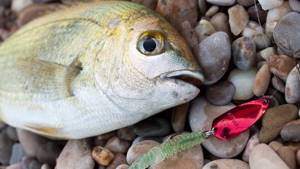
The use of edible rubber at sea is absolutely justified. The ratio of bites for edible rubber and ordinary rubber is approximately 4:1. Just salty is not enough - it must contain attractants. Crayfish from YUM and Relax work great for active fish, but when activity decreases, it is better to replace them with more expensive but effective baits. Perhaps the most popular among fish and many fishermen in the Black Sea are silicone baits Bug Ants 2–3, Rock Clow 2 produced by the Japanese company Ecogear. Any tire measuring 1-3 inches will do. I would like to focus your attention on what works best: creatures - crayfish, crabs, shrimp, nymphs.
Worms are bait you can’t do without at sea. They are used for both bottom and pelagic jigs, as well as on lead rigs. Power Isome from Marukyu - no competition! The fish bites on it, even when the bait is completely at rest. Traditional twisters, vibrating tails and slugs are best used as an additional option in the situation of “what else does this fish need?!” They do not work as stably as creatures, but they can help out during periods of no biting.
Additional equipment Don't forget to take a headlamp or a clip-on flashlight for the visor of your cap. Lipgrip will not be superfluous. So we got together. Let's go to the sea. Stop! Don't forget your camera!
Any rocky beach or pier can be a fishing spot. On a sandy beach, without thorough knowledge of the area, the results may not be very good. The optimal place for sea fishing is a rocky shore with a pile of algae-covered boulders in the water and changes in depth. But first, it’s better to choose a regular pebble beach. As a rule, good places are found on the edges of organized beaches, on their borders with a wild beach. You can try to see the bottom topography from the steep shore, find spots of stones and grass, or you can swim with a mask. If 20–30 meters from the shore you find a change in depth or a transition from a pebble to a sandy bottom, feel free to come to this place in the evening. On the piers, especially those illuminated at night, horse mackerel is excellently caught.
Fishing time determines tactics. When fishing light-colored, as a rule, fish with a small mouth bite, so the bait should be small: a worm, a 1.5-inch twister, a small slug. Micro-oscillators, retractable leash, micro-jig, bombards, split-shot and Texas rig with a small hook size are used.
With the onset of darkness, large-mouth predators become more active, for which the size of the bait is not of great importance, and therefore, you can switch to crank wobblers and large rubber creatures. The basic equipment for fishing with silicone is a drop shot and a retractable leash. When catching bottom fish during the day, the species composition is more diverse than at night. At night, 90% of the catch is scorpionfish - the sea ruff. The bite is stronger at night, so it is better to gain your first experience of sea spinning in the dark, especially since there are fewer people on the shore and more fish in the water. And yet, at night in the dark your senses become heightened. You begin to contemplate with your hands. Your heart skips a beat at the slightest touch of the bait and is ready to burst out of your chest with a powerful, confident bite. Rule: light - small baits, dark - large. Having decided on the time and place of fishing, we take the first steps in an exciting activity - sea spinning.
For bottom fishing, I would recommend starting with cranks, a drop shot, a microjig and a retractable leader. For pelagic fishing - microjig, small minnow wobblers, micro-oscillators with silicone twisters, and even better, worms.
Objects caught (in order of frequency of occurrence) are scorpionfish, croaker, crucian carp, goby, rock perch. When fishing with cranks from the bottom, first practice in a shallow area of the sea, on a pebble beach with a relatively flat bottom. The principle of fishing is as follows: we tie a shock leader made of fluorocarbon 30–50 cm long to a cord, and a wobbler to it. After casting, we make several long sharp pulls, deepening the wobbler until it touches the bottom. Having felt the bottom, we pause the wiring, let the wobbler float to the surface and repeat the attempts. Touch-ascent. Touch-ascent. Uniform wiring with tapping the soil with a wobbler blade is fraught with blind hooks and is only possible on a flat bottom. In addition, most bites occur during pauses.
Objects caught (in order of frequency of occurrence) are scorpionfish, croaker, crucian carp, goby, rock perch. If it doesn’t matter what kind of equipment you fish with, in the dark, start with a drop shot. We install the equipment. A fluorocarbon leash with a length of at least 50 cm. The weight is a “Tyrolean stick” with a weight closer to the upper limit of the test of your spinning rod. We tie a round offset hook 30–40 cm from the “Tyrolean stick” so that the bend of the hook points down and the sting is on top, otherwise there will be idle bites. After touching the bottom with the load, we give a little slack and make several jerks with the spinning rod with an amplitude of 30–40 cm, lowering and raising the tip.
To understand what is happening, it is enough to imagine what is happening at the bottom of the sea. The load lies on the ground, the fishing line is taut, the bait is 10–20 cm from the bottom. When you lower the tip of the spinning rod and loosen the tension, the bait goes down; when you raise the tip of the spinning rod, the bait rises. After two or three series of jerks in place, we make a smooth reeling with the reel, trying not to tear the load off the bottom, and again a series of jerks. Thus, we fish the bottom area and the space above it. As a rule, it is caught very well and there are bites on every retrieve. If the fish is inactive, reduce the amplitude of the jerks and the reeling speed.
Bites often follow the wiring repeatedly. From strong blows like “give back the spinning rod” to light pinching of baits. If there are unconvincing bites, stop the wiring and pause. You can make a slight tremor with the tip of the spinning rod without loosening the tension of the braid. Scorpionfish very often catch up with bait that suits their taste.
Objects caught (in order of frequency of occurrence) are crucian carp, greenfish (rulena), smarida (perch), scorpion fish, goby, red mullet, croaker, rock perch. We mount the tackle: weight - “Tyrolean stick” on a fluorocarbon leash 3 lb thick, 10–15 cm above the “Tyrolean stick” in any way you like, mount a leash 1.2–1.5 m long 5–10 lb with hook No. 8– 10 according to Japanese classification. We put a 2–3 cm long bait on the hook. The animation ranges from sharp jerks to smooth stretches with pauses of 5–10 seconds. A little trick: when fishing with edible silicone, you don’t need to hook it right away. Let the fish eat the bait. For example, when a crucian carp bites, it makes several short jerks, and if you pause, you will wait for a powerful pull to the depth - a signal for active action - hooking.
Crucian carp, by the way, is a worthy opponent. It can be recognized by its methodical powerful thrusts into depth. Rule: when hooking, it is better to raise the spinning rod up and not allow the braid to become slack, as the fish tends to escape from you into the crevices between the stones. Don't give her this chance.
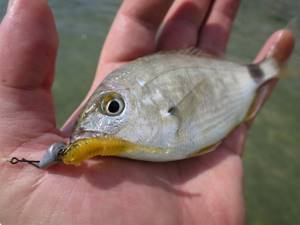
Objects caught (in order of frequency of occurrence) are crucian carp, horse mackerel, greenfish (rulena), smarida (perch), scorpion fish, goby, red mullet, croaker, rock perch. The method is applicable both during the day and at night. We attach a jig head to what I hope has become a traditional fluorocarbon leash using a fastener.
When pelagic jigging, the retrieve speed should be quite high. Inhabitants of salt waters move very quickly compared to their freshwater counterparts. Basic retrieving is a quick reel with twitching of the tip of the spinning rod and periodic short pauses every 3-4 seconds. No need to cut. If you happen upon a flock of horse mackerel, there will be several fractional strikes - bites - during the retrieve. When playing, try not to give in to slack, but also don’t force things, otherwise the number of departures will increase.
When jigging near the bottom, we perform the retrieval by tossing the head using the tip of the rod, trying to immediately tear the bait away from it when lightly touching the bottom. The animation can differ radically: from lightly jumping from pebble to pebble to sharp, intense jerks with an amplitude of more than half a meter. Two or three intense sharp tosses of the bait - pause. The lighter the load, the fewer snags.
A few rules to help you enjoy sea spinning. 1. Never grab a fish across the body with an open hand. Many, even seemingly harmless sea fish, have at least one spine, which, you can be sure, will stick into your hand or finger. 2. Most fish can be picked up by the mouth. You won't find any sharp teeth. The exception is crucian carp and dogs. 3. Try to avoid contact with the fins of the scorpion fish. It feels like a nettle sting, but with a more serious sting, it feels like a wasp sting. 4. Remember the outline of the dragon fish. She looks a lot like a bull. It’s better not to pick it up! The thorns contain poison that causes excruciating pain to a person and causes long-term numbness of the entire limb. 5. Wear comfortable shoes if you are going to fish on the rocks. 6. Move very carefully on large wet stones - they are terribly slippery. 7. If you plan to fish in estuaries, be sure to take mosquito repellent.
Try it. I am sure that on one of your night fishing trips you will feel a sharp blow at the other end of your tackle, hear the squeal of a friction clutch releasing 20-30 meters of cord, be able to stop the underwater locomotive, but decide that the fish is stuck in the rocks, however, with perseverance and skill, after repeatedly tugging the braid, taut as a nerve, jerking left, right, and into the depths, you will eventually pick up the fish for which most experienced rock fishers come to the seashore. This is a croaker. A kilogram croaker will give a head start to a 5 kilogram pike. This is an opponent worthy of respect. Give him freedom, and he will definitely return and thank you with new sensations of victory. Catching a croaker is much more enjoyable than eating it.
About 200 species of fish live in the Black Sea. Some of them, such as blue shark, tuna or swordfish, prefer to stay in the depths, others come close to the shore to feed. Spinning rods most often come across:
goby; scorpionfish, or sea ruff; sea crucian; greenfinch, or wrasse; dog; garfish; bluefish; horse mackerel; croaker catch at sea
Read other articles, reviews and testimonials:
- Which spinning rod to choose for rock fishing? Choosing a reel for rock fishing.
- Choosing a spinning rod for fishing in the Black Sea. Fishing with a bombard and microjig from the shore.
- How to catch red mullet. Tackle for catching red mullet
- Rock fishing in the Black Sea. Which spinning rod should I take with me? Best lures for rock fishing
- Fishing for garfish on the Black Sea. Methods and techniques for catching Black Sea garfish
Specifics of sea fishing on the shores of the Crimean Peninsula
Not long ago, sea fishing became very popular among Crimean vacationers. This especially applies to places where there is a very warm place and shallow depth.
In such places, the fish remain to rest, accumulating in small groups every day.
Conventionally, the entire territory of the Crimean Peninsula can be divided into three large-scale sections:
- Sea of Azov;
- O. Sivash;
- Black Sea.
Moreover, each of the zones has its own peculiarity in terms of fishing. For example, on the shores of the Black Sea, as a rule, mullet, flounder, mackerel and sawfish are caught. And the southern coast of Crimea will be chosen for fishing by those who love sea fishing.
Note: in the Sea of Azov, as a rule, fishing is carried out equally on the open sea and from the shore.
The main prey found in its waters are flounder, mullet, pike perch, pelingas, sprat and goby. In addition, sturgeon enter the sea during their migration to spawn. The most “fishy” area on the Black Sea is the Balaklava area, where there is an abundance of sea fox, horse mackerel, sea bass and redfish.
Whereas from the shore, it is generally possible to get a good catch of greenfish, sea ruffe and other small fish. And on the West Bank, especially near the rocky shores of Dzhangul and Tarkhankut, you can count on a more generous catch: rapa, crabs, mussels, gobies, white salmon, horse mackerel, and mullet.
In addition, in this area it is possible to fish for katran, a Black Sea shark, from a boat.
As a rule, many fishermen go to Lake Sivash to hunt for a goby; its habitat is deep water, which is why you can hardly expect a good catch here without having a boat. Despite the fact that the local fauna of Sivash includes over fifty varieties of fish, shrimp and shellfish, the juicy, tasty and healthy meat of the gloss flounder is of greatest value to fishermen.
It is worth noting that the population of this fish in this region is considered the largest in the entire Azov-Black Sea basin. It is traditionally believed that in the Black Sea it is better and more efficient to fish from a boat or boat. But this does not mean at all that fishing in the Black Sea from the shore is completely impossible.
Moreover, this can be fishing from breakwaters or fishing directly from the shore.
If this is fishing from breakwaters, then the gear is not particularly complex. This is an ordinary donka, with one or two hooks. The rod can be of any length, as long as it can withstand casting a heavy load. Any inertia-free reel can be used. Line diameter is 0.25–0.3. Hooks with a long shank, size No. 7–8.
Most often this is fishing at night, when the fish rushes to the coastal zone. Shrimp, sea worm, mussel, and pieces of fish are used as bait. The bite can be detected either by the tip of the rod with a firefly attached to it, or by using a bell or bell.
But many fishermen prefer to detect a bite “on the finger,” when the line is passed between the fingers and any touch of the fish to the bait on the hook is felt. Fishing in the Black Sea from the shore especially attracts fans of catching pelengas. But this fish is not caught everywhere.
It comes out to certain areas of the coast, and in fairly large flocks. And then the real holiday begins for local fishermen.
This fish is caught with bottom gear at a great distance from the shore. Therefore, it is justified to use long, powerful rods 4–4.5 m long with a test that can withstand the force of casting equipment weighing 100–200 grams. Such a weight of cargo is needed to keep the equipment in place even during waves.
In general, for such fishing, the ideal option would be powerful surf rods with a reel with a spool size of at least 4000, but even larger is better. Of course, you can also supply size 3000. But how long the reel will work with such loads and such weights of loads that will have to be pulled over long distances and, sometimes, through obstacles, remains in question.
It is important to make the equipment correctly. Pelengas is a pelagic fish, accustomed to feeding not from the bottom, but in the water column.
Accordingly, the hooks with the nozzle should be higher than the bottom. This is achieved by using small foam floats placed on a leash next to the hooks as a hook lifter. Floats can be used from winter float rods.
You can limit yourself to foam balls placed on the hook itself. But the lifting force may not be enough to lift both the leash and the hook with bait from the bottom. In order to ensure that the fishing line rises above the bottom, a specially shaped sinker is used, which becomes vertical at the bottom.
And due to its position and size, it lifts the fishing line above the bottom. But you still can’t do without floats.
The most used bait for bearings is the sea worm. Although you can use a regular worm, the number of bites will be several times less. The most attractive time for catching pelengas is morning and evening. Bites that are very sharp are fixed using the end of the rod or a bell is used. Source: “jeduvkrym.ru; blesna.net"
What kind of fish is found in the Black Sea?

This area is home to almost 180 species of fish. Often caught by fishermen:
- Ruffs.
- Flounder.
- Mullet.
- Gobies.
- Sea bass.
- Red mullets.
- Horse mackerel.
- Sprat.
- Herring.
- Acne.
- Anchovy.
In summer it occurs:
- Tuna.
- Pelamida.
- Mackerel.
- Rarely, but you come across sultanas.
- Beluga.
- Sargans.
- Gorbyl.
- Dark.
There is an abundance of fish of different sizes in the Black Sea. Gobies are popular and are a delicacy for many. To attract their attention, it is better to place the bait at the very bottom. There are a lot of mullet in the sea near the shore, singili, a medium-sized fish with an orange spot on the cover of the gills.
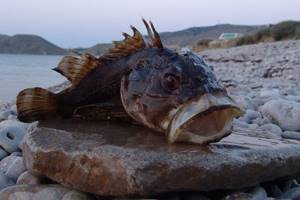
Fishing in the Crimea, closer to the Caucasus, is successful for small horse mackerel. Quite large individuals are found not far from Georgia and Abkhazia. Horse mackerel often recklessly searches for prey, literally jumping out of the water. If you find yourself at sea at such a moment, catching horse mackerel will not be difficult.
Catching sea crucian carp with a fishing rod is successful in the waters of the Black Sea; shrimp will be used for bait. Beautiful bright wrasses are found in the coastal zone closer to rocks and stones overgrown with algae. The wrasse fits on almost any tackle. There are a lot of perches in the sea; anglers love to catch this type of fish.
There are, of course, a lot of crabs, shrimps, and mussels of various sizes in the sea. But poisonous fish can also be caught on a hook: dragonets, sea ruffes, which are similar in appearance to other species. You need to be careful. If the fish is unfamiliar to you, it is better to release it back to avoid poisoning.
Technique: casting, retrieving, retrieving
The behavior of a marine predator, just like a freshwater predator, is closely related to seasonal climate changes. Also, the activity of sea fish varies greatly during the day. As a rule, sea fish feed most actively in the warm season and in the fall, before cold weather.
As for the time of day, the greatest activity should be expected at morning and evening dawns.
A fertile time for fishing from the shore is the night, when a marine predator emerges from the depths onto the coastal shallows in search of food. However, these general recommendations are very conditional, since the behavior of fish in different seas - southern and northern, deep and shallow - is very different.
Therefore, it is always better to make inquiries in advance about the water area where you plan to fish in order to know what you need to be prepared for. On the Black Sea, night fishing with a light spinning rod for bottom predators in the coastal strip has become extremely popular.
This kind of fishing is very interesting and exciting, and it is accessible to everyone - no special gear is required for it, and there is no need to go out to sea on a boat.
Silicone baits are used on weight heads, which are carried with standard jig wiring, and wobblers. The main trophies are scorpion fish, bison and croaker, and if the weight of the former often does not exceed 100 g, then a croaker caught on a hook can weigh more than 5 kg, and this is already a very serious rival, the fishing of which will most likely be remembered for a lifetime. When fishing with a spinning rod at sea, the same techniques are used as in freshwater fishing.
Casting
A feature of sea fishing is the frequent need to make long casts (if fishing occurs from the shore) and strong winds, which are often present at sea. In this situation, sharp power casts are required, which, provided that long rods and heavy baits are used, can “break through” even a hurricane wind, sending the bait over a distance of several tens of meters.
Wiring
When catching bottom predators in the coastal zone with a jig, a standard step-by-step retrieve is used, familiar to all spinning anglers from fishing in freshwater bodies: after casting, the bait must be allowed to sink to the bottom, after which several turns of the reel handle are made, then a pause, during which the bait falls to the bottom again , then the reel handle rotates again.
When fishing with cranks, the wobbler can be driven evenly, while the bait will go along the bottom, digging the soil with a spatula and fighting off stones.
Stop and go wiring is also suitable: after casting, you need to deepen the bait to the bottom, then wait a short pause, during which the wobbler rises slightly from the bottom. This is followed by several turns of the reel handle, after which the bait again hits the bottom with a spatula, then again there is a short pause.
When fishing with oscillating spoons and jigs in the water column, near the surface or near the bottom, mostly uniform fishing is used. But when catching large and strong fish far from the shore, slow retrieval of the bait is unacceptable: these sea predators respond primarily to fast and sharp retrieves.
Fishing
In the sea you often have to fish from breakwaters or piers, and in this case, just like when fishing from a boat, the line goes into the water at an angle close to 90 degrees. This is fraught with a high risk of rod breakage when fishing for a strong sea predator. In such a situation, a landing net with a long handle will help out the fisherman. Source: "fishcave.ru"
Fishing in the sea, with what gear?
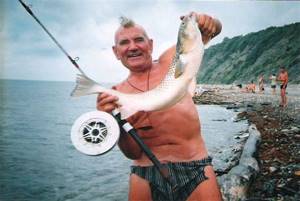
The tackle can actually be anything, but it’s still the same:
- durable and powerful
- resistant to frequent gusts of wind
- easily cast over long distances
- withstands powerful water fluctuations.
Spinning rods, float rods, telescopes, bottom gear, and tyrants are effective and popular.
- The spinning rod, which is quite resistant to corrosion, is suitable for sharp hooking. Tuna, croakers, crucian carp, anchovy, eels, sea bass, bonito, gobies, and croaker weighing up to 5 kg go well with it. Preferred places for spinning fishing are rocks, piers, away from the beach. 2. Donka is preferable for catching small fish of medium size specimens. The donka is effective for use in shallow water, in calm places. The tackle is good for beginners when fishing for eels, crucian carp, sea bass, croaker, and flounder. 3. The telescopic fishing rod is suitable for long casting, fishing from rocks and catching beluga, anchovy, tuna, bonito, herring, sea crucian carp. 4. A float fishing rod is ideal for catching small fish, but you need to choose the fishing line and hooks for this tackle correctly. Fishing from the pier in places with an average depth of no more than 2 m with a muddy sandy bottom is successful for perch, crucian carp, bonito, garfish, horse mackerel, gobies, and eels. 5. Tyrants - homemade fishing rods with hard reels. Fishing from the shore is successful with herring, eels, gobies, and sea crucian carp.
The most popular types of fish when fishing in Yalta
Sea fishing in Yalta is entertainment for most of the city’s indigenous residents, and many visitors who come to the summer capital of Crimea love this activity. Here you can practically go out to the Yalta embankment at any time and see many fishermen sitting on the pier with a spinning rod in hand.
In late spring or early summer you can see the following picture: some are diving from the pier, while others are immediately fishing.
Sea fishing in Yalta is distinguished by the fact that you can practice this wonderful pastime almost all year round. Let's take a little look at what kind of fish live in the Black Sea.
If we take the more well-known Black Sea fish, and there are an average of 167 species, then 103 of them are marine, 27 have a medium brackish habitat, and 37 species prefer a freshwater habitat. Most of the primary freshwater fish that live in coastal lakes located near the sea are able to live in brackish sea water.
Some species of herring and sturgeon are considered anadromous species, while other species have long adapted to the marine environment. Most of the fish in the Black Sea are immigrant fish that came here from other seas.
There are those, such as bluefish and bonito, that live and breed in the Black Sea, and go to Mramornoe for the winter, where the water is warmer.
As mentioned above, Yalta fishing is good because you can fish all year round and enjoy this activity. And each season is interesting for its fishing of certain types of fish. Let's look at what types of fish can be caught in Yalta and at what time of year.
Horse mackerel
Horse mackerel is one of the most popular fish species, which is caught in Yalta directly from the pier or on a boat at sea. Horse mackerel usually lives at a depth of 10–50 meters and is not afraid of the noise of boat engines and the splash of oars. This predatory fish feeds on anchovy and other smaller fish, and is caught on an empty hook.
The best time to catch horse mackerel is after sunrise and before sunset.
Practically, horse mackerel fishing occurs all year round using a spinning rod, which includes an inertial reel, a fishing line of 40 - 70 meters with a diameter of 0.3-0.5 mm and a “Tyrant” bet. Here you need to pay a little more attention to the rate, since it can change depending on the fishing.
It is a two-meter piece of 0.3 mm fishing line, where every 15-20 cm short leashes are tied from fishing line up to 10 cm long with nickel-plated hooks at the end. Hooks should have a long shank No. 7-8.
Barabulya
Red mullet is one of the delicious fried fish that can be caught from the pier in Yalta. Another name for her is “sultana”. They start catching red mullet in late May - early June, when the water temperature is 16-19 degrees.
For fishing, use float gear, a small hook No. 4-5 (if fishing is done with a sea worm, then the shank of the hook should be long), the preferred bait is a sea worm, boiled shrimp, sea flea (small crustacean), boiled chicken.
The red mullet is a nimble fish and bites quickly, so you need to be constantly on alert to hook it in time.
You should also know that when fishing with a moving float, the bait must be lowered to the very bottom, then raised back, otherwise you may miss the bite. It is better to use two leashes with hooks that are located below the sinker. If the hooks are high, then haddock and goby may bite instead of red mullet, since they prefer to be closer to the bottom.
bluefish
One of the favorite fishing trips in Yalta is bluefish fishing. Usually fishing occurs from a pier or from a boat. Near the shores of Yalta, bluefish are small, and they call them “strigunets”; I have not seen anything larger than 40-50 cm. For fishing, use a spinning rod with an inertial reel, a 0.4-0.5 mm fishing line and a spoon.
Some people who don’t use a sinker fill the concave parts of the spinner’s leader with molten tin, but they must first be tinned.
It’s better, of course, to catch bluefish from a boat, and first figure out where they hunt for different fish. Bluefish hunt in schools, so small splashes on the water can be seen from the boat. For those who like to taste this fish, I’ll tell you a delicious recipe that requires the following ingredients:
- Bluefish fish 5 pcs.
- A few sprigs of rosemary.
- Vegetable oil.
- Lemon juice.
- Ground paprika.
- Salt pepper.
We take the already cleaned fish and make three small cuts on the sides on each side. Season the fish with salt, allspice and ground paprika.
We put sprigs of rosemary inside the fish and sprinkle each fish with lemon juice. Lubricate each fish with oil and carefully place it on a grill with hot coals, or in the oven at home. The best sauce for this dish is tartar.
Features of winter fishing
With the arrival of cold weather, the nature of fishing in the Black Sea changes somewhat. The main features of winter fishing are:
- Strong winds and even storms are often observed.
- It's easy to miss a bite because of the waves.
- A strong wind usually blows from the sea.
- Hooking must be done as carefully as possible.
- The cast must be made as far as possible.
Important advice: depending on the waves and wind strength, it is necessary to weigh down the tackle or vice versa.
During this period, it is most successful to fish out:
- Mullet.
- Horse mackerel.
- Anchovy.
- Sea crucian carp.
- Garfish.
During the winter months, you need to be especially careful when choosing gear. You can use any suitable for sea fishing, especially spinning rods and bottom fishing rods.
The main requirement for winter gear is a powerful fishing rod and hooks numbered five to seven. You can fish from the shore, pier or rocks (the latter requires special training and experience). During this period, it is much more effective to use such baits that live in these places. Ideal are small pieces of fresh fish (preferably anchovy), sea worms, shrimp and twisters.
Important tip: you can try boiled shrimp on garfish.
Recommended gear for offshore fishing
For successful fishing, this issue must be taken seriously. After all, if in the middle of the sea the gear deteriorates or fails, you will have to return to the shore. That is why it is necessary to choose a spinning rod or fishing rod wisely. Taking into account the peculiarities that characterize fishing in the Black Sea from a boat or other watercraft, gear must meet certain requirements. They must have the following mandatory qualities: power and strength, resistance to wind and waves, and the ability to cast over long distances.
Spinning rods are most often used for fishing in the Black Sea. This tackle is highly resistant to corrosion and is suitable for sharp hooking. It is mainly used to fish away from the coastline. You can use a spinning rod to catch tuna, crucian carp, conger eel, perch or gobies.
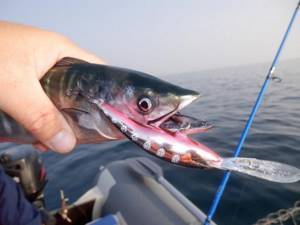
In general, fishing in the open sea does not require many types of gear. Experienced fishermen prepare only two types of spinning rods: for jig and for fishing on a bet, equipped with reels. In this case, multipliers are also suitable, although not large ones, but small ones. From a huge selection of baits, you can take with you a set of jig heads equipped with vibrating tails, as well as hooks with a long shank. When sea fishing, experienced spinning anglers always have soft silicone baits with them. These can be twisters of various colors and sizes, as well as vibrating tails, etc. Some use jig heads and “Cheburashkas”. The weight of these sinkers primarily depends on the depth of fishing. At the same time, do not forget that the water in the sea is salty. In addition, although many people think that there is no visible current in it, it actually exists, and quite decently so.
What is so special about fishing from the shore?
It is believed that fishing is effective as far as possible from the shore, at depth. Let’s say that you don’t have a boat, and you only have a spinning rod in your arsenal. But this is also an interesting process in its own way. For spinning, a spinning reel and a rod of any length are suitable. It is better to fish at night, when the fish swim to the shore in schools. Suitable baits include shrimp, mussels, and sea worms.
A large catch from the shore is possible with a donka up to 5 m in length and a sinker weighing at least 200 g, as well as with a surf fishing rod with a reel spool size of over 4000 mm. Hooks and attachments also need to be selected correctly for a particular fishing rod.
Fishing from the surf in bad weather and storms is good with surfcasting. It is during bad weather that many worms, mollusks, and crustaceans are thrown ashore. These are the best baits for predators, and the fishing method is good for long casts to places rich in fish, located 10-12 m from the shore.
For extreme sports enthusiasts, the type of fishing “rock fishing” from the rocks is suitable. The fish swims for prey to coastal areas, to high rocks. A telescopic rod up to 5 m long and with a sinker up to 200g is suitable for the tackle.
Features of fishing in the Sea of Azov
The Sea of Azov is very shallow; you usually have to fish at a depth of 2-5 m. The sea area is rich in fish, but here, in order to remain with a good catch, it is important to know the hunting areas of the predator . Since there is practically no vegetation and stones in the Sea of Azov, there is simply nothing to catch on when searching, and finding fish in such a situation is very difficult.
Goby can be caught in the coastal zone using light and ultralight gear . To hunt for pike perch and flounder, it is better to use a boat .
In general, it is not the sea itself that is more promising for fishing, but the estuaries on its coast - there a spinning angler can usually count on a more decent catch.
Catching
The gear is collected, things are in the boat - we set sail. We move away from the shore at a sufficient distance and turn on the echo sounder. We found a promising place: we are in the middle of an underwater bank, the depth is excellent, the echo sounder shows fish - that’s it, let’s start fishing. Where to begin? I would recommend starting with jig fishing. It's more sporty and, in my opinion, fun. The rule clearly works in the sea - the larger the bait (naturally, within reasonable limits), the more often the bites, but it is not a fact that the fish will be larger. This has already been verified. I was very surprised when one day I caught a ruff of the same size using a 12-centimeter twister! At a depth of 20 meters, the stepped head of a sinker heavier than 40 g is well conveyed. I think that the color of the bait does not matter much at such a depth, although when the sun is at its zenith, at a depth of up to 25 m it is quite light (provided that the water is clear), so you can experiment with colors. Milky-white baits have proven themselves well, although, say, on a black silicone goby from ORKA, during my last trip I caught a rather weighty ruff. I decided to try this bait, knowing that the majority of the ruffe’s diet consists of fish from the Goby family. This leads to the conclusion that the main role is played not by color, but by the contrast of the bait. As for reeling, you should try to move the bait along the bottom slowly, taking longer pauses before reeling than what you are used to doing when fishing for pike perch or pike perch. Before tearing the bait off the bottom, you can play it a little, making short jerks and only then reeling it in. Don't rush to select a line after the bait is on the bottom under the boat. Very often, bites occur precisely when the essentially vertical lure begins. By the way, in such cases, try fishing with a jig! If you find a good place, then bites will happen on almost every retrieve, and without leaving one place you can catch more than a dozen ruffs. As soon as the bites become less frequent, move, but only a short distance. It can be difficult to navigate in open water, the main thing is that you don’t go completely off the bank to great depths. Here your assistant is an echo sounder, without which it will be difficult in an unfamiliar place. When you are pretty tired of the ruffs, I advise you to try fishing with tyrants or leave some of the hooks bare and bait some. The fishing technique is simple: slightly throw the stake away from you with a pendulum movement and send it into a free fall to meet the seabed. As soon as the sinker reaches the bottom, close the bow on the reel, take out the slack, tighten it and wait for bites. This is where species diversity comes into play in the catch. Horse mackerel, bonito, smarida, whiting, and bluefish are caught on bare hooks; for baited ones - sea crucian carp, gobies, croakers. When fishing with artificial baits (mainly silicone twisters, vibrotails, etc.), the main, I would say, dominant object will be the sea ruff. Large gobies and large trout are caught less often; stingrays may be caught as exceptions - in the Black Sea there are two types of them: the spiny stingray (sea fox) and the stingray (sea cat). Also found are the Black Sea shark (katran) and the Black Sea flounder (kalkan). These are all fairly large fish, and catching them can bring a lot of excitement, but catching them with artificial bait is extremely rare. But if you make something like a donkey and put a small fish (mackerel, whiting) or a piece of the loin of a larger fish on a long leash (preferably made of thick “braid”) with a large single hook, then who knows... as they say, lucky are drunkards, fools and amateurs. I talk for so long about where, how and why, but I practically haven’t told who we are catching. It's time to give an ichthyological certificate about which fish are most often found in our catches.
What do experienced fishermen advise?
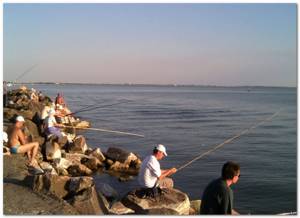
Russian fishing is always emotional and varied, and the Black Sea is proof of this. You can fish with a wide variety of gear, in different places, at any time of the year, in any weather, even the most inclement, with any bait. Fish in the Black Sea are apparently invisible, of various sizes. There are more than 10 species of gobies alone. However, when fishing at sea, study the habits of the fish you want to catch:
- It is very important what gear is used. Don't take cheap ones with you, many of them are not effective at sea.
- Take several types of bait with you at once. Some can be collected right off the coast.
- If you fish with tyrant, homemade gear, then use several types of them at once.
- Of course, a purchased tyrant is better. It's more efficient.
- If there are a lot of seagulls in the area, it means there are a lot of bonito in the sea.
Fix a regular firefly bell on the end of the rod, this will make it easier to recognize the bite. On the Black Sea, fishing from the shore at night is successful when the fish are in coastal areas. Use shrimp, sea worms, and mussels for bait. There will be more interest in fishing if you manage to catch a decent pike, flounder, redfish or pelengas. You can also catch well from the shore, not only from a boat, as many people think when they come to the Black Sea.
To increase catch, fishermen often use bite activators, which are attractive to fish from long distances. They stimulate the fish's appetite due to the pheromones included in their composition. However, despite the natural composition of the components, a ban is expected on some additives, but today you can still buy them.
What types of fishing are available in Gelendzhik + prices
1. Fishing from the shore or pier
- affordable and free types of fishing, provided that you bring all the equipment with you. If you come on vacation without fishing rods and equipment, you will have to pay from 2.5 to 6 thousand rubles for them in local stores, but you will know that you bought exactly what local fish are caught with. The sellers of such stores are experienced fishermen. They will tell you what gear and tools are best to take, as well as where and when is the best time to fish in Gelendzhik Bay.
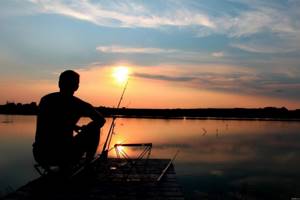
A typical day on the beach, downtown pier or marina will produce plenty of small fish. For the best catch, choose places where there are fewer people, and fish with float rods or rods with nods, since there is a lot of debris and ropes on the bottom near the shore, and this, in turn, breaks the fishing line. It is best to go to the Tolstoy Cape area, where the beaches are less accessible to vacationers. If you are going to fish in the heat of the summer, don’t forget to take a Panama hat. The best time for fishing during the holiday season is a summer evening. If you see mosquitoes flying over the water, it means fish are somewhere nearby! We recommend that trophy hunters go fishing from a pier or shore in the fall, and select favorable weather conditions for catching certain types of fish. Goal setting is the key to success!
2. Fishing from a boat or yacht in Gelendzhik.
This type of fishing is great for beginners and those who like a comfortable holiday. Ready-made offers and fishing tours are perhaps the best option to diversify your vacation with an event such as fishing. You will not be alone on the boat, but accompanied by experienced local fishermen and trip organizers. They will share fishing secrets and subtleties with you, give you all the necessary equipment and food, take you to a fishing spot, which they find using an echo sounder, and in the end, they will offer to fry and taste your catch, giving culinary tips along the way! Did you know that experienced chefs recommend adding lemon juice when baking mullet? What is the most delicious mullet - fried? And sea fishermen know for sure!
Prices for a one-time three-hour foray into the sea with the rental of a boat, which will have a captain and a guide who knows good fishing spots, will cost from 600 to 1000 rubles per person per hour. A typical trip lasts 3-4 hours. Departure time is by agreement.
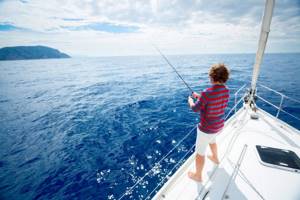
Fishing in the sea from a yacht or boat in Gelendzhik is especially popular among vacationers, so there are many offers at any time of the year. The cost of fishing on a boat as part of a group starts from 500 rubles per hour. Full rental of a boat with captain and guide will cost from 4,000 rubles per hour, yachts - 5,000 rubles per hour
People accustomed to comfort can rent a beautiful and fast yacht in Gelendzhik. Depending on the class of the vessel and the maximum number of passengers, rental will cost on average from 5,000 to 30,000 rubles per hour.
